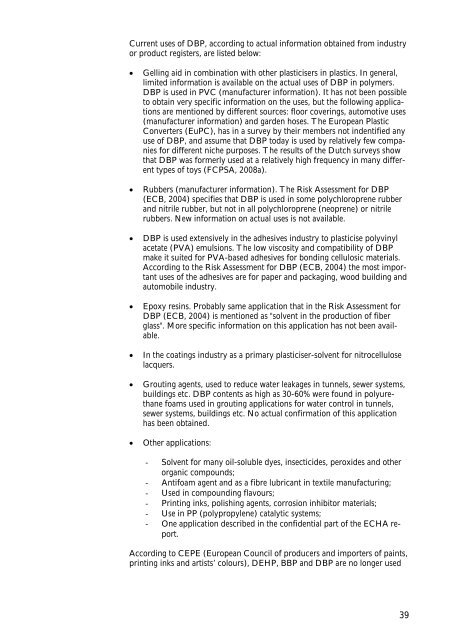Identification and assessment of alternatives to selected phthalates
Identification and assessment of alternatives to selected phthalates
Identification and assessment of alternatives to selected phthalates
Create successful ePaper yourself
Turn your PDF publications into a flip-book with our unique Google optimized e-Paper software.
Current uses <strong>of</strong> DBP, according <strong>to</strong> actual information obtained from industry<br />
or product registers, are listed below:<br />
� Gelling aid in combination with other plasticisers in plastics. In general,<br />
limited information is available on the actual uses <strong>of</strong> DBP in polymers.<br />
DBP is used in PVC (manufacturer information). It has not been possible<br />
<strong>to</strong> obtain very specific information on the uses, but the following applications<br />
are mentioned by different sources: floor coverings, au<strong>to</strong>motive uses<br />
(manufacturer information) <strong>and</strong> garden hoses. The European Plastic<br />
Converters (EuPC), has in a survey by their members not indentified any<br />
use <strong>of</strong> DBP, <strong>and</strong> assume that DBP <strong>to</strong>day is used by relatively few companies<br />
for different niche purposes. The results <strong>of</strong> the Dutch surveys show<br />
that DBP was formerly used at a relatively high frequency in many different<br />
types <strong>of</strong> <strong>to</strong>ys (FCPSA, 2008a).<br />
� Rubbers (manufacturer information). The Risk Assessment for DBP<br />
(ECB, 2004) specifies that DBP is used in some polychloroprene rubber<br />
<strong>and</strong> nitrile rubber, but not in all polychloroprene (neoprene) or nitrile<br />
rubbers. New information on actual uses is not available.<br />
� DBP is used extensively in the adhesives industry <strong>to</strong> plasticise polyvinyl<br />
acetate (PVA) emulsions. The low viscosity <strong>and</strong> compatibility <strong>of</strong> DBP<br />
make it suited for PVA-based adhesives for bonding cellulosic materials.<br />
According <strong>to</strong> the Risk Assessment for DBP (ECB, 2004) the most important<br />
uses <strong>of</strong> the adhesives are for paper <strong>and</strong> packaging, wood building <strong>and</strong><br />
au<strong>to</strong>mobile industry.<br />
� Epoxy resins. Probably same application that in the Risk Assessment for<br />
DBP (ECB, 2004) is mentioned as "solvent in the production <strong>of</strong> fiber<br />
glass". More specific information on this application has not been available.<br />
� In the coatings industry as a primary plasticiser-solvent for nitrocellulose<br />
lacquers.<br />
� Grouting agents, used <strong>to</strong> reduce water leakages in tunnels, sewer systems,<br />
buildings etc. DBP contents as high as 30-60% were found in polyurethane<br />
foams used in grouting applications for water control in tunnels,<br />
sewer systems, buildings etc. No actual confirmation <strong>of</strong> this application<br />
has been obtained.<br />
� Other applications:<br />
- Solvent for many oil-soluble dyes, insecticides, peroxides <strong>and</strong> other<br />
organic compounds;<br />
- Antifoam agent <strong>and</strong> as a fibre lubricant in textile manufacturing;<br />
- Used in compounding flavours;<br />
- Printing inks, polishing agents, corrosion inhibi<strong>to</strong>r materials;<br />
- Use in PP (polypropylene) catalytic systems;<br />
- One application described in the confidential part <strong>of</strong> the ECHA report.<br />
According <strong>to</strong> CEPE (European Council <strong>of</strong> producers <strong>and</strong> importers <strong>of</strong> paints,<br />
printing inks <strong>and</strong> artists’ colours), DEHP, BBP <strong>and</strong> DBP are no longer used<br />
39

















